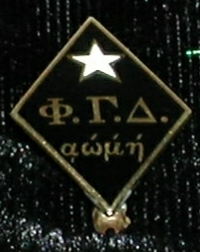 |
Founders' Badges, 1848
The badge of Founder Naaman Fletcher (Jefferson 1849), presented by his son to the Fraternity. This style was used for almost ten years until the convention added a raised border and cord around the edge of the badge.
All the earliest badges were produced by W. W. Wilson of Pittsburgh. After his retirement in 1860 or 1861, the northern chapters used H. Richardson and Co. of Pittsburgh.
Early in this century, this badge was modified with a modern barrel clasp, seen at the bottom. Compare it with the "C" or hook clasp on Elliot's badge below.
|
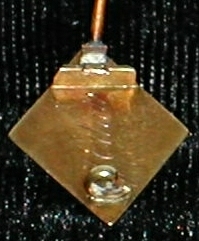 |
A rear view of Founder James Elliott's (Jefferson 1848) badge, given to the Fraternity by his son.
In 1923, the 75th Anniversary Ekklesia approved the reinstitution of the Founders' badge as the only badge to be used by Phi Gamma Delta. At that time, this badge was used by our official jewelers, Balfour, to create dies for the new badges.
Note the original "C" or hook clasp, the raised "T" pin, and the sideways engraving "J. Elliott". Another striking feature is how very thin is this badge compared to today's badges.
|
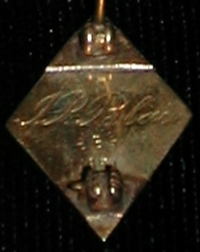 |
Badge of John P. Blair (Washington 1851). Presumably the badge's thinness prompted the modern addition of gold underneath the replaced pin and barrel clasp. Note the engraved name. Below it is a letter "B" representing Beta Chapter at Washington, inside a starburst. This motif appears on modern badges also. One wonders if this was added at a later time, like the clasp.
|
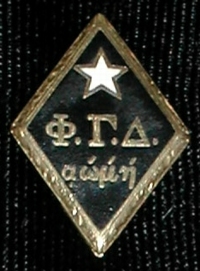 |
First Change, Late 1850s
Badge of John W. Heath (DePauw 1860). Size is similar to the Founders' badge above; however, note the small border with filigree engraving.
In the middle or late 1850s, the badge face was raised with the addition of a border. Apparently it was usually engraved like Heath's, or like the Sterrett badge below.
In 1859, jeweler W.W. Wilson quoted this design as costing $5.00 with name engraved, while the original design cost $3.50. Six inches of attached chain and stickpin cost $2.50. A badge with a diamond in the star cost about $15, depending on the stone.
|
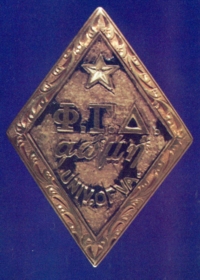 |
University of Virginia, Late 1850s
This badge was excavated from a Confederate encampment where Major D. Sterrett (Howard 1857, Virginia 1860) lost it. Almost all the enamel had fallen out of this badge by the time it was recovered.
It is somewhat larger than the Founders' badge, and has "Univ. of VA" inscribed at the bottom of the badge. It was apparently not made by the official jeweler. Personal and chapter preferences led to wide varieties in badge design.
Another badge of this type is in the UVA archives.
|
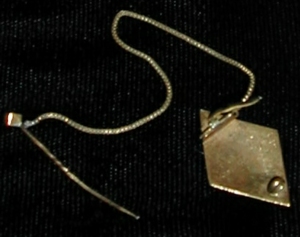 |
1860s
Rear of badge of David D. Johnson (Allegheny 1867) - just like the Heath badge above, except the face is slightly bowed instead of flat.
To keep from losing their badges, brothers added stickpins and chains. This stickpin has a spiral twist in the center to keep it in the fabric.
|
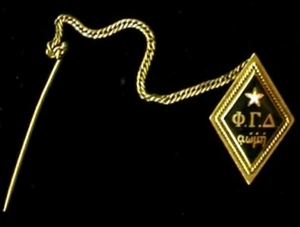 |
Early 1870s
Badge of L. W. Andrews (Yale 1875). This badge reflects the bowed front and rope border added sometime before 1870.
Jewelers would sometimes leave off the rope border, an omission frequently criticized in the magazine and at conventions.
|
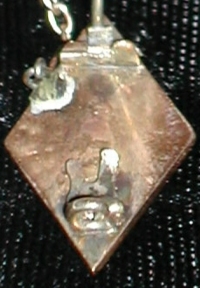 |
Back of Fowler's badge, showing the "butterfly" clasp and ring for attaching chain. The "butterfly" folds down to lock the stickpin into the hook.
Chapter letter stickpins like the one shown above were long ago banned.
|
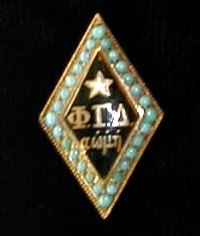 |
1890s
Badge of Joseph Casper Walier (M.I.T. 1895). This is more evidence of the variety of badges worn up until the 1890s. Compare this jeweled version with the two plain versions of Albert Barnes, below, from the same time period.
|
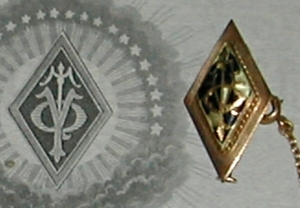 |
Badge and charter detail for QTV, the Latin-letter fraternity whose Maine chapter joined Phi Gamma Delta in 1899. Note the damaged enamel.
The clasp is a screw-type; the head of the screw is visible behind the badge's bottom corner. It is hollow and screws upward to secure the pin.
|
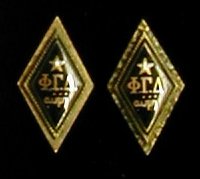 |
Badges of Albert C. Barnes (Pennsylvania 1892). Note the similarity to the QTV badge above.
Jewelers would make diamond "blanks" with rope borders, and fill in the center depending on the fraternity. Hence, many diamond-shaped fraternity badges of the late nineteenth century resemble each other.
|
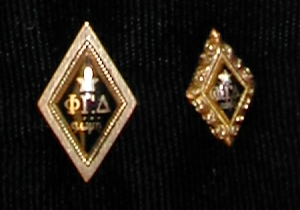 |
The 1892 Convention mandated the "half-size" badge (right). Compare the previous version, left.
These belonged to Edmond L. Worden (Cornell 1903).
|
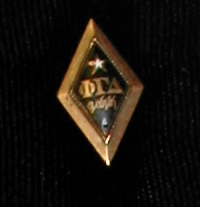 |
The 1903 Ekklesia banned jeweled badges. It mandated this plain badge with rope border and wide beveled edge. Its measurements were specified: 23/32 inch high, the width equilateral with the sides.
Ekklesiai would tinker with the size between 1913 and 1917, but this basic badge was the standard until the return of the Founders' Badge in 1923.
|
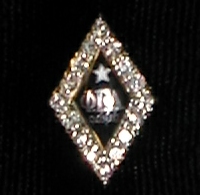 |
This badge of white gold and diamonds is the most stunning badge in the Headquarters collection. The face is relatively small; with the jeweled border, it is comparable in size to a Founders' badge.
The Western Reserve Chapter presented it to Karl Lemmerman (Western Reserve 1908) in appreciation for his service as Archon Treasurer from 1918 to 1923. They paid for it through contributions from every chapter. A similar badge was reportedly given to the Archon President by his chapter.
|
 |
Side view of Lemmerman badge, showing the diamond settings, raised profile, and curved face.
This style is known as the "sweetheart's badge." It was sometimes given to fiancées and wives in the middle to late twentieth century, despite our ban on using the badge as ornamental jewelry.
|
History of the Badge
The photo below shows the changes and varieties over time. Note the rope edge used for many years. Also note the raised and rounded face compared to the flat Founders' badge.
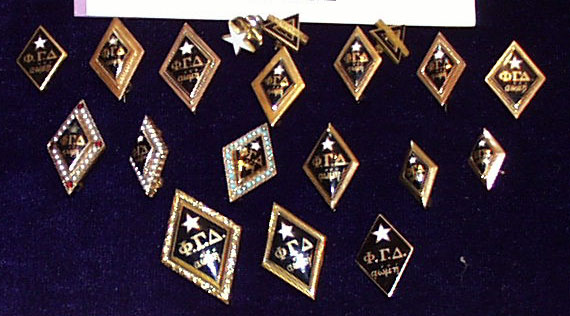
Phi Gamma Delta has had many official jewelers over the years, and during the 1880s and 1890s, had several at the same time. One was J. F. Newman and Co. of New York City, founded by John F. Newman (CCNY 1869). Many of the badges pictured above are samples presented by his company to the Fraternity Archives.
The white star at the top is the pledge pin. From 1901 to 1913 it had the Greek letters of the Fraternity in the center. Next to it are the pledge and member badge of the Delta Colony, probationary chapters seeking to become fully chartered chapters of Phi Gamma Delta.
Some other tidbits about badges:
1. The 55th Ekklesia, 1903, not only banned jeweled badges and stickpins. It also decreed that only a brother's mother, sister, wife or fiancée could wear the badge. This is still observed today.
2. The 64th Ekklesia, 1912, determined that badges be numbered on the back in the order of one's initiation into a chapter. This is no longer practiced.
Back to Museum & Library page
|